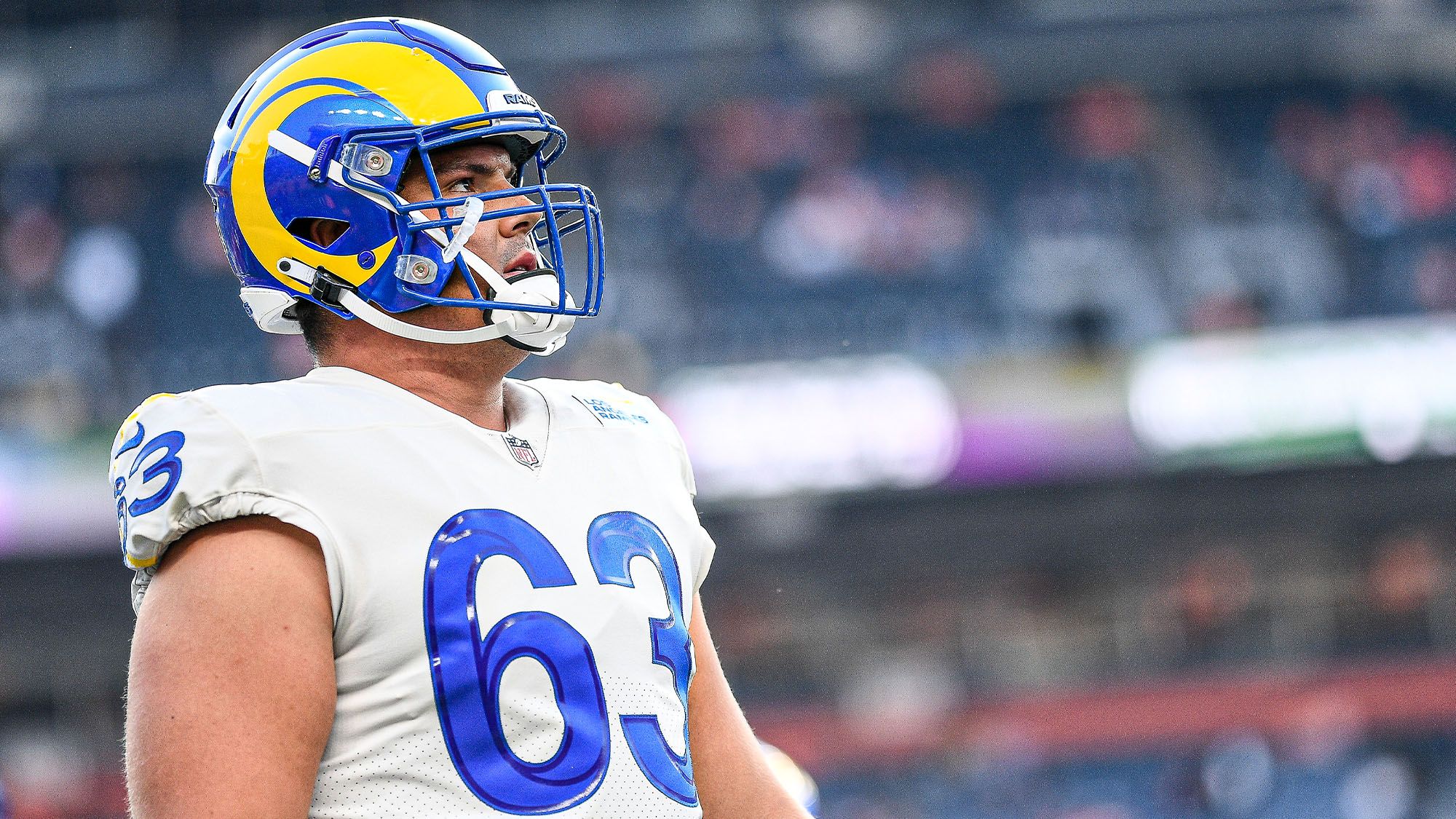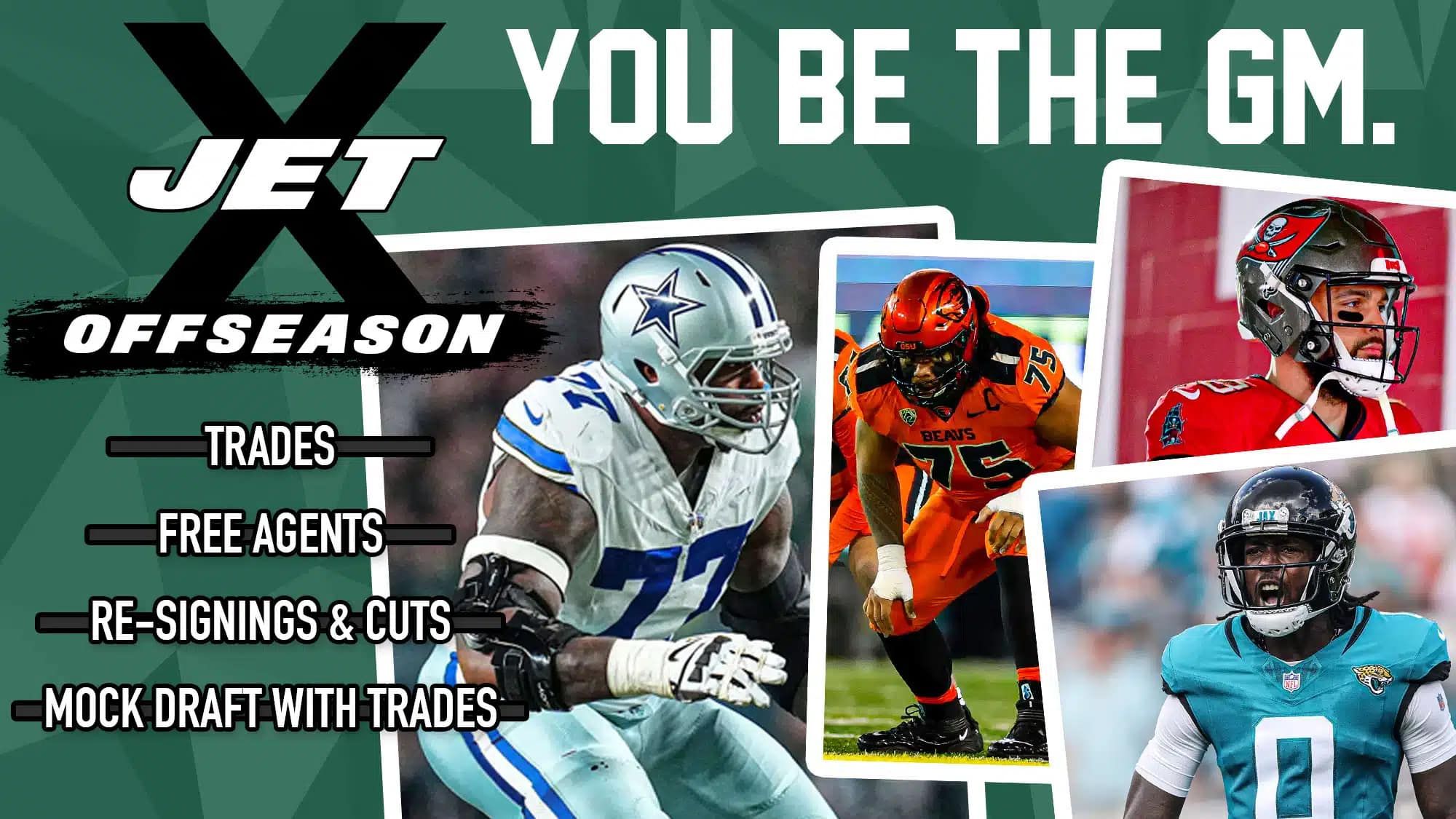The New York Jets should be cautious when pursuing Austin Corbett
The NFL’s 2022 free agent guard market is deep, and we’ve already covered quite a few options for the New York Jets:
It’s time to take a look at another top-tier guard option: Austin Corbett of the Los Angeles Rams.
Corbett is a good starter who should command a lot of interest. I think he’s someone the Jets should take a look at. However, one key weakness in Corbett’s game has me skeptical of whether he is worth a large contract.
Before getting to the big red flag that concerns me about Corbett, let’s evaluate how much money he might earn on the open market and then run through some of the positives he brings to the table.
Play: 👉 the Jet X Offseason Simulator
Contract estimation for Austin Corbett
Spotrac estimates that Corbett will fetch a four-year deal worth $35 million ($8.75 million per year). That would currently rank as the league’s 12th-largest contract among guards in terms of total value and the 13th-largest in terms of average annual value.
For a soon-to-be 27-year-old guard with 33 starts under his belt over the last two seasons (including six playoff starts and a 2021 Super Bowl championship), that’s really not a bad price.
We’ll see if Corbett actually lands at that number, though. He can definitely earn more than that based on the recent contracts signed by similarly-aged free agent guards like Andrus Peat (5yrs/$57M), Graham Glasgow (4yrs/$44M), and Ereck Flowers (3yrs/$30M).
Let’s pump Corbett’s AAV up a little bit and say he earns a multi-year deal worth around $10 million per year.
Austin Corbett’s run-blocking
Corbett is a good run-blocker. His 2022 team should feel confident they’ll be getting their money’s worth from him in that phase, especially if they employ a zone-heavy running game.
In 2020, his first career season as a full-time starter, Corbett earned a 73.4 run-blocking grade at Pro Football Focus, which ranked 12th-best out of 67 qualified guards. He took a step back in 2021 but still performed respectably as his 67.4 run-blocking grade ranked 30th out of 69 qualifiers.
A smaller guard (6-foot-4, 306 pounds) who sacrifices size for athleticism, Corbett is a nice zone-blocker who played in a Rams offense that has similarities to the Jets’ offense.
Corbett earned a 74.2 zone-blocking grade at PFF in 2020, placing 19th out of 67 qualified guards. However, he dipped to a 65.8 mark in 2021, ranking 39th out of 69 qualifiers.
The dip is concerning but Corbett made up for it in the playoffs with some huge blocks to help the Rams take home a world title. Corbett had a 78.6 zone-blocking grade between the NFC Championship Game and the Super Bowl.
While you’re probably not getting a star run-blocker in Corbett, he should do a pretty good job for any zone-based team.
Austin Corbett’s durability and penalty minimization
Continuing with our final positives before getting to my big concern, Corbett offers reliable durability and a low frequency of penalties.
Corbett missed three games late in his 2018 rookie season with a foot injury but has not missed any games due to injury besides those (he was frequently a healthy scratch over his first two seasons, explaining the rest of his 10 missed games from 2018-19).
Over the past two years, Corbett started all 39 regular season and playoff games for Los Angeles.
Corbett is also good at avoiding penalties. He has been flagged 12 times over 3,158 career regular season and playoff snaps. That’s an average of 3.8 penalties per 1,000 snaps, well below the 2021 league average for guards (5.7).
The main question mark with Austin Corbett: His pass protection
Corbett’s pass protection is what has me pondering whether I would be comfortable committing to him as one of my long-term starting guards. He doesn’t have a very good track record of production as a pass-blocker despite playing in a Rams offense that is friendly for offensive linemen.
In 2021, Corbett allowed 34 pressures on 674 pass-blocking snaps, a pressure rate of 5.04% that placed him 38th out of 68 qualified guards. That’s a smidgen worse than the 2021 league average for guards (4.94%). In addition, his PFF pass-blocking grade of 63.8 also landed in the middle of the pack, ranking 33rd.
Corbett had better production from a pressure perspective in 2020 as he allowed 24 pressures on 661 pass-blocking snaps, a pressure rate of 3.63% that ranked 21st out of 67 qualifiers. But his PFF pass-blocking grade was still mediocre. He ranked 41st out of 67 qualifiers with a 60.0 pass-blocking grade.
Here’s why his pass-blocking grade was still below-average that year despite giving up fewer pressures: his job was super easy compared to other linemen. Corbett’s pressure numbers were strong thanks largely to the benefits of the scheme he played in, which is why he didn’t earn much credit in the grading system.
The Rams’ offense (particularly prior to Matthew Stafford’s arrival) provides a ton of help to its offensive linemen through its usage of pre-snap motion, play-action, bootlegs, and rollouts. It’s likely that anybody leaving that scheme will perform worse elsewhere.
When Corbett had better pressure numbers in 2020, it was mainly because he only dropped into a “true pass set” on 32.2% of his pass-blocking snaps, per PFF, ranking sixth-lowest among all guards.
True pass sets are any pass-blocking snaps that do not involve a quick pass, screen, rollout, bootleg, or anything else that prevents the linemen from having to protect a traditional pocket for an extended period of time. So, the fewer of those that a lineman has to play, the easier his job is.
With the addition of Matthew Stafford in 2021, the Rams’ offense opened up a bit more. Corbett had to drop into a true pass set on 45.8% of his pass-blocking snaps, ranking 18th-highest out of 66 qualified guards. With the tougher workload, Corbett was exposed a bit as his pressure rate dipped to a below-average level.
But here’s another concern: despite the increase in true pass sets thanks to Stafford’s arrival, the Rams actually continued getting the ball out fairly quickly, and yet Corbett still struggled.
Los Angeles held the ball for an average of 2.66 seconds per dropback in 2021, ranking 12th-fastest out of 32 teams. When you adjust Corbett’s 5.04% raw pressure rate (which ranked 38th out of 68 guards) for how long the Rams held the ball versus league average, he jumps to an adjusted pressure rate of 5.18%, which ranked 41st out of 68 guards.
On true pass sets, Corbett allowed a pressure rate of 8.41% in 2021, ranking 43rd out of 66 qualified guards. This is a bad sign regarding Corbett’s ability to pass-block when the offense needs him to execute in a one-on-one situation without help from schematic effects.
The Jets’ offense possesses some similarities to the Rams’ offense but it certainly does not manufacture as much assistance for its linemen. New York’s quarterbacks held the ball for 2.88 seconds this past season (fifth-longest of any team). Corbett would be asked to work a lot harder with the Jets, putting his true-pass-set woes on full display.
Austin Corbett has value but just isn’t great enough for an expensive contract
This is a player who could end up as one of the 15 richest players at his position. While the pass-blocking rankings we saw above are certainly not atrocious, none of them are close to top-15 caliber, which is where you’d like a player to be if you’re giving him a top-15 contract.
Most of the available evidence points to Corbett being a below-average pass-blocker going forward, especially if he leaves the Rams’ scheme. An offensive lineman who isn’t good in the passing game is only worth so much money.
I see Corbett as a third-tier option on the guard market.
Brandon Scherff is likely alone in the first tier. Laken Tomlinson and James Daniels make up the second tier.
Corbett joins players such as Connor Williams in the third tier – guys who are undoubtedly starting-caliber but possess enough question marks to knock their impact (and thus their price) down to a more middling level.


